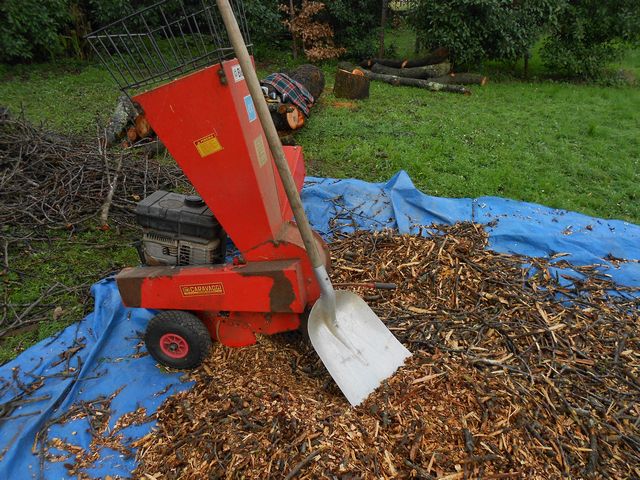Mulching garden waste
[vc_row el_position=”first”] [vc_column] [vc_row_inner el_position=”first last”] [vc_column_inner width=”2/3″] [vc_column_text el_position=”first last”]
An havvy work, it’s still the best way to reuse the garden scraps
Mulching require some effort even using a powerful engine equipment, it isn’t an easy job to do outside, but there are a lot of positive things behind it: reduce very much the scrap volume, recycle in house large quantity of garden waste and finally produce high quality composter to be used in the garden or in the vegetable garden.
[/vc_column_text] [/vc_column_inner] [vc_column_inner width=”1/3″] [vc_column_text el_class=”vc_author_box” el_position=”first last”]
About the author
 Owner & handyman at Casa Gentili
Owner & handyman at Casa Gentili
Marco served serveral multinational companies over 20 years, when world faced economic crisis in 2008 he gave up his staff activity and focused on the legacy property. >> Read more
[/vc_column_text] [/vc_column_inner] [/vc_row_inner] [/vc_column] [/vc_row] [vc_row] [vc_column] [vc_separator el_position=”first”] [vc_row_inner el_position=”last”] [vc_column_inner width=”2/3″] [vc_single_image image=”4780″ img_size=”full” img_link_target=”_self” el_position=”first last”] [/vc_column_inner] [vc_column_inner width=”1/3″] [vc_column_text el_position=”first last”]
Garden waste
The working area shows a high volume of small branches, as a result of knoking down three cherry trees; major branches has been cutted in pieces, but still remain a huge quantity of material that need to be remove from the soil: burned, or brought away from a recycling company
[/vc_column_text] [/vc_column_inner] [/vc_row_inner] [/vc_column] [/vc_row] [vc_row] [vc_column] [vc_separator el_position=”first”] [vc_row_inner el_position=”last”] [vc_column_inner width=”2/3″] [vc_column_text el_position=”first last”]
The mulcher and the working area
The most important role is played by the mulcher, a 5 HP engine can do a great job for a 5000 sm garden (my mulcher has been bought nearly 20 years ago and still works pretty good). This is a kind of equipment that most probably will be used 5 or 6 times per year, but without that managing a large garden would be quite hard as the quantity af waste produced over one year is impressive.
In case the mulching is performed far from the composting area, It’s a good practice to put an havvy linen over the soil, so to facilitate the cleaning at the end of the mulching when the compost will be moved to the stock area.
[/vc_column_text] [/vc_column_inner] [vc_column_inner width=”1/3″] [vc_single_image image=”4782″ img_size=”full” img_link_target=”_self” el_position=”first last”] [/vc_column_inner] [/vc_row_inner] [/vc_column] [/vc_row] [vc_row] [vc_column] [vc_separator el_position=”first”] [vc_row_inner el_position=”last”] [vc_column_inner width=”1/4″] [vc_single_image image=”4781″ img_size=”full” img_link_target=”_self” el_position=”first last”] [/vc_column_inner] [vc_column_inner width=”3/4″] [vc_column_text el_position=”first last”]
Personal Protection Equipment
The use of a garden mulcher requires a physical effort for the operator, working with a noisy and highly vibrating machinery, equipped with hammers and cutting blades. The equipment has mechanical safety, nevertheless operator shall always wear glasses, gloves, hear muffs and of course footwear protection to work in safety conditions.
For the same reason noone should stand in the area all around the machinery when operating.
[/vc_column_text] [/vc_column_inner] [/vc_row_inner] [/vc_column] [/vc_row] [vc_row] [vc_column] [vc_separator el_position=”first”] [vc_row_inner el_position=”last”] [vc_column_inner width=”1/3″] [vc_column_text el_position=”first last”]
Tooling in action
Small branches fitted into the smaller funnel will be chipped by the highly rotating blades producing small items easily converted into compost.
Pay attention to the sub-branches that may stop the fitting of branches in to the funnel; it’s a good practice to cut the wilder sub-branches (more perpendicular) before chipping, while other branches may be bended by the operator while pushing the branch into the funnel.
[/vc_column_text] [/vc_column_inner] [vc_column_inner width=”2/3″] [vc_single_image image=”4783″ img_size=”full” img_link=”http://casagentili.com/wp-content/uploads/2013/02/mulching_working_branches_-025.jpg” img_link_target=”_self” el_position=”first last”] [/vc_column_inner] [/vc_row_inner] [/vc_column] [/vc_row] [vc_row] [vc_column] [vc_separator el_position=”first”] [vc_row_inner el_position=”last”] [vc_column_inner width=”1/3″] [vc_single_image image=”4773″ img_size=”full” img_link_target=”_self” el_position=”first”] [vc_column_text el_position=”last”]
Using the top funnel (the wrong way)
The larger funnel is very usefull for the smaller branches, leaves or mixed material, nevertheless to make to job easy it’s very improtant to pick the material in small quantity without mixing it to much, or it will be very difficult or impossibile to fit into the funnel or
[/vc_column_text] [/vc_column_inner] [vc_column_inner width=”1/3″] [vc_single_image image=”4772″ img_size=”full” img_link_target=”_self” el_position=”first”] [vc_column_text el_position=”last”]
Using the top funnel (the right way)
a set of the small branches in line (nearly parallel or oriented in the same direction) will make the job much easier and will reduce highly the effort to fit into the funnel.
[/vc_column_text] [/vc_column_inner] [vc_column_inner width=”1/3″] [vc_single_image image=”4795″ img_size=”full” img_link=”http://casagentili.com/wp-content/uploads/2013/02/mulching_original-stock_-the-right-way.jpg” img_link_target=”_self” el_position=”first”] [vc_column_text el_position=”last”]
Preparing the stock for muching
Well organized stock, all items in line so the operator with just a single movement takes the items from the stock and insert a bunch of it into the funnel, without additinal work.
[/vc_column_text] [/vc_column_inner] [/vc_row_inner] [/vc_column] [/vc_row] [vc_row] [vc_column] [vc_separator el_position=”first”] [vc_row_inner el_position=”last”] [vc_column_inner width=”1/3″] [vc_column_text el_position=”first last”]
The working area
At the end of the job the area is completely clean and there is no more sign of the havvy work performed to reduce the high volume of waste material.
[/vc_column_text] [/vc_column_inner] [vc_column_inner width=”2/3″] [vc_single_image image=”4793″ img_size=”full” img_link_target=”_self” el_position=”first last”] [/vc_column_inner] [/vc_row_inner] [/vc_column] [/vc_row] [vc_row] [vc_column] [vc_separator el_position=”first”] [vc_row_inner el_position=”last”] [vc_column_inner width=”1/3″] [vc_single_image image=”4778″ img_size=”full” img_link=”http://casagentili.com/wp-content/uploads/2013/02/mulching_worm_-057.jpg” img_link_target=”_self” el_position=”first last”] [/vc_column_inner] [vc_column_inner width=”2/3″] [vc_column_text el_position=”first last”]
Let the worms work it out for you
When stocked, the worms will continue to mulch the waste material; it’s very important to keep the compost wet, and in Summer time this is not easy. A good practice is to build up a composter with 3 storage areas to separate the ready for use from the new one and from the semi composted; this will make easyer to mix peridically the material as there is always a certain part of it that reamain uncomposted
[/vc_column_text] [/vc_column_inner] [/vc_row_inner] [/vc_column] [/vc_row] [vc_row] [vc_column] [vc_separator el_position=”first”] [vc_column_text el_position=”last”]
What’s next
[/vc_column_text] [/vc_column] [/vc_row] [vc_row el_position=”last”] [vc_column] [vc_row_inner el_position=”first last”] [vc_column_inner el_class=”vc_gardening_box” width=”2/3″] [vc_column_text el_position=”first last”]
Casagentili’s Takeaway
Buy a solid steel mulcher, avoid plastic equipment and electric motors (too week for an havvy work like this); pay attention when preparing the stock to mulch, place the brances in line and you’ll save time and effort during the job.
Do not mulch too fine if you have enough room for your compost, once more you’ll save time and effort during the muching activity and finally remember to mix the compost.
[/vc_column_text] [/vc_column_inner] [vc_column_inner width=”1/3″] [vc_column_text el_position=”first last”]
Would you do us a favour?
We’re committed to keep Casa Gentili live for long, it’s coming far away fom past, lets bring it forward for future generations. We live and breathe by our guests, so if you think we succeeded or not, post your comment and let us know; we’re always open!
We only ask that if you’ve found this post helpful, would you share it with your friends?
[/vc_column_text] [/vc_column_inner] [/vc_row_inner] [/vc_column] [/vc_row]




Comments are closed.